Table of Contents
Introduction
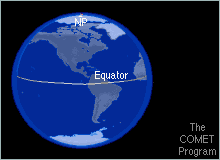
This collection of information, on tropical meteorology for aeronautical forecasters, consists of selections from the Introduction to Tropical Meteorology, 2nd Edition online textbook.
After completing this study guide you should be able to:
- Describe the characteristics of tropical climates and their role in the global system
- Describe the processes that influence the motion of the atmosphere
- Identify the contributors to the global circulation pattern and their characteristics
- Identify the characteristics of remotely-sensed observations
- Identify the sources of intraseasonal and interannual variability in the tropical atmosphere
- Determine the presence of Kelvin and n=1 Equatorial Rossby waves
- Identify ENSO's climatological impacts
- Describe the formation of tropical precipitation and factors that influence it
- Use observation tools and NWP to create a forecast
This section begins with an overview of energy balance and the global climate system. Various definitions of the tropics are presented. The role of the tropics in the global energy and momentum balance is explained. Atmospheric structure of temperature and humidity are discussed in terms of latitudinal variability. Pressure ranges and scales of atmospheric motion in the tropics are reviewed. Seasonal and geographic distribution and the diurnal cycle of surface temperature and the influencing factors are examined in detail. Finally, we review tropical air masses and climates.
The topics in this section support your development of competency in analyzing and continuously monitoring the weather situation as part of your aeronautical forecasting activities. With the challenges associated with forecasting in the Tropics, solid background knowledge of the information that follows is important as you develop your mental model of the weather situation as part of your daily forecast process.
Let's begin by defining the tropics.
EACH link will open a new tab or window, close the tab or window to return.
- Defining the Tropics
- Energy Balance
- Atmospheric Structure
- Temperature
- Moisture and Precipitation
- Momentum Balance
- Regional Influences
- References
Remote Sensing
This section focuses on remote sensing—the primary method of observing weather and climate across the global tropics. We will explore how remote sensing is used and examine the types of information that it provides over formerly data-void regions. Both satellite and radar imagery are important tools along with other data sources in analyzing the state of the atmosphere and for monitoring changing conditions. Throughout the forecast process, remote sensing data can provide information about hazards to aviation such as low clouds, precipitation, dust and volcanic ash.
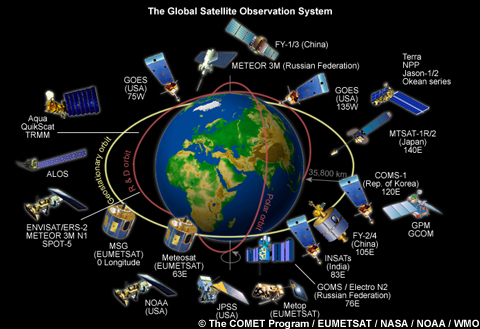
Each link will open a new tab or window, close the tab or window to return.
- Introduction to Remote Sensing
- Radar in the Tropics
- Clouds and Precipitation
- Dust
- Volcanoes
Global Circulation
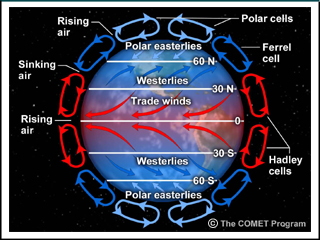
This section begins with a review of the general principles of atmospheric motion. An overview of the general circulation of the atmosphere and ocean is presented including stratospheric general circulation. Special emphasis is given to the Hadley circulation including its maintenance, seasonal migration, northern and southern hemispheric differences, and the contrast between tropical and midlatitude wind systems. Tropical circulations are examined in a theoretical framework as responses to heating at the equator. Monsoons, their conceptual models, seasonal evolution, and variability are explored with special emphasis given to the West African Monsoon.
Forecasting in the tropics is strongly influenced by the effect of intense surface heating on the general circulation of the atmosphere and seasonal prevailing winds. A good understanding of the general circulation in the tropics will help you to develop forecasts that reflect the general pattern expected with modifications based on emerging weather conditions.
Each link will open a new tab or window, close the tab or window to return.
- Atmospheric Motion
- General Circulation
- Ocean Circulation
- Equatorial Heating
- Monsoons
- Tropical Circulation
- Low Level Jets
Tropical Variability
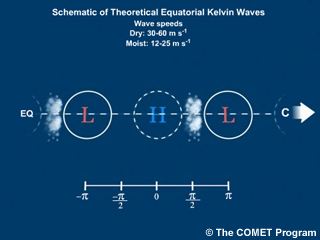
This section presents an overview of major cyclical patterns that dominate tropical intraseasonal and interannual variability, including the impact on higher latitudes. Characteristic atmospheric and oceanic patterns for the oscillations are presented and methods for tracking their evolution are described.
Tropical variability influences weather on many levels, including the development of tropical cyclones and enhancement or suppression of precipitation. Monitoring the development and progression of tropical waves can provide important cues for forecasting conditions of importance to aeronautical operations.
Each link will open a new tab or window, close the tab or window to return.
- Intraseasonal Variability
- Interannual Variability
Moisture and Precipitation
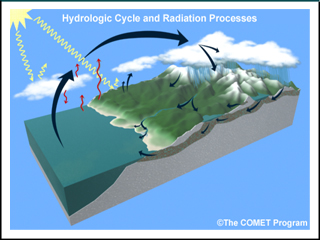
The global energy and water cycles are driven by tropical heating and moisture transport. The evaluation of thermodynamic energy is used to distinguish between fair weather, stormy weather, and the effect of dry intrusions, such as the Saharan Air Layer. Cloud and precipitation formation in the tropics varies diurnally, sub-seasonally, and interannually. All of these considerations should be used as part of the forecast process.
The presence of clouds and precipitation can greatly impact aviation operations. Accurate and timely forecasting of these conditions is an important part of aeronautical forecasting.
Each link will open a new tab or window, close the tab or window to return.
Tropical Cyclones
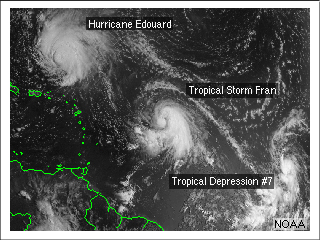
In this section, we focus on the seasonal influence on tropical cyclone development and the geographic distribution of these storms. The conditions associated with these systems can have severe impacts on aviation operations, and often close airports.
Each link will open a new tab or window, close the tab or window to return.
Observation, Analysis, and Prediction
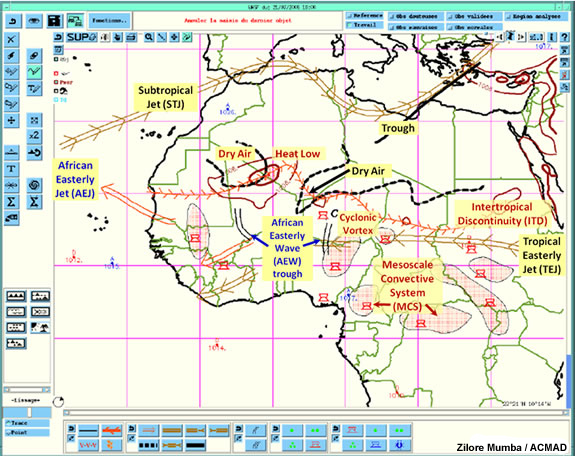
This section describes the challenges of tropical weather forecasting. Then, we examine types of weather analysis techniques used by tropical forecasters. The last topics focus on numerical weather prediction including: the fundamentals, comparisons of statistical and dynamical models, ensemble techniques, cumulus convection, and forecast verification and validation.
Each link will open a new tab or window, close the tab or window to return.
- Challenges
- Analysis
- Numerical Weather Prediction
- Fundamentals of Numerical Models
- Data Assimilation
- Sources of Model Forecast Errors
- Dynamical and Statistical Models
- Ensemble Prediction Systems
- Cumulus Convection in NWP
- Verification